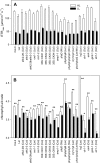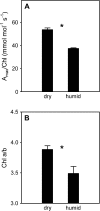Redundant roles of photoreceptors and cytokinins in regulating photosynthetic acclimation to canopy density
- PMID: 19240103
- PMCID: PMC2657547
- DOI: 10.1093/jxb/ern364
Redundant roles of photoreceptors and cytokinins in regulating photosynthetic acclimation to canopy density
Abstract
The regulation of photosynthetic acclimation to canopy density was investigated in tobacco canopies and in tobacco and Arabidopsis plants with part of their foliage experimentally shaded. Both species acclimated to canopy light gradients and partial shading by allocating photosynthetic capacity to leaves in high light and adjusting chloroplast organization to the local light conditions. An investigation was carried out to determine whether signalling mediated by photoreceptors, sugars, cytokinin, and nitrate is involved in and necessary for proper photosynthetic acclimation. No evidence was found for a role for sugars, or for nitrate. The distribution of cytokinins in tobacco stands of contrasting density could be explained in part by irradiance-dependent delivery of cytokinins through the transpiration stream. Functional studies using a comprehensive selection of Arabidopsis mutants and transgenics showed that normal wild-type responses to partial shading were retained when signalling mediated by photoreceptors or cytokinins was disrupted. This indicates that these pathways probably operate in a redundant manner. However, the reduction of the chlorophyll a/b ratio in response to local shade was completely absent in the Arabidopsis Ws-2 accession mutated in PHYTOCHROME D and in the triple phyAphyCphyD mutant. Moreover, cytokinin receptor mutants also showed a reduced response, suggesting a previously unrecognized function of phyD and cytokinins.
Figures




Similar articles
-
Cytokinin import rate as a signal for photosynthetic acclimation to canopy light gradients.Plant Physiol. 2007 Apr;143(4):1841-52. doi: 10.1104/pp.106.094631. Epub 2007 Feb 2. Plant Physiol. 2007. PMID: 17277095 Free PMC article.
-
Acclimation of plants to light gradients in leaf canopies: evidence for a possible role for cytokinins transported in the transpiration stream.J Exp Bot. 2001 Jul;52(360):1563-74. doi: 10.1093/jexbot/52.360.1563. J Exp Bot. 2001. PMID: 11457917
-
Canopy light gradient perception by cytokinin.Plant Signal Behav. 2007 Nov;2(6):489-91. doi: 10.4161/psb.2.6.4573. Plant Signal Behav. 2007. PMID: 19704594 Free PMC article.
-
Photosynthesis and resource distribution through plant canopies.Plant Cell Environ. 2007 Sep;30(9):1052-71. doi: 10.1111/j.1365-3040.2007.01683.x. Plant Cell Environ. 2007. PMID: 17661747 Review.
-
Photosynthetic acclimation to simultaneous and interacting environmental stresses along natural light gradients: optimality and constraints.Plant Biol (Stuttg). 2004 May;6(3):254-68. doi: 10.1055/s-2004-817881. Plant Biol (Stuttg). 2004. PMID: 15143434 Review.
Cited by
-
Strigolactones are positive regulators of light-harvesting genes in tomato.J Exp Bot. 2010 Jun;61(11):3129-36. doi: 10.1093/jxb/erq138. Epub 2010 May 25. J Exp Bot. 2010. PMID: 20501744 Free PMC article.
-
Phototropins but not cryptochromes mediate the blue light-specific promotion of stomatal conductance, while both enhance photosynthesis and transpiration under full sunlight.Plant Physiol. 2012 Mar;158(3):1475-84. doi: 10.1104/pp.111.187237. Epub 2011 Dec 6. Plant Physiol. 2012. PMID: 22147516 Free PMC article.
-
Cytokinin Regulates the Etioplast-Chloroplast Transition through the Two-Component Signaling System and Activation of Chloroplast-Related Genes.Plant Physiol. 2016 Sep;172(1):464-78. doi: 10.1104/pp.16.00640. Epub 2016 Jul 7. Plant Physiol. 2016. PMID: 27388681 Free PMC article.
-
Cytokinin and abiotic stress tolerance -What has been accomplished and the way forward?Front Genet. 2022 Aug 9;13:943025. doi: 10.3389/fgene.2022.943025. eCollection 2022. Front Genet. 2022. Retraction in: Front Genet. 2024 Mar 19;15:1399259. doi: 10.3389/fgene.2024.1399259. PMID: 36017502 Free PMC article. Retracted. Review.
-
Light signalling shapes plant-plant interactions in dense canopies.Plant Cell Environ. 2021 Apr;44(4):1014-1029. doi: 10.1111/pce.13912. Epub 2020 Oct 22. Plant Cell Environ. 2021. PMID: 33047350 Free PMC article. Review.
References
-
- Ahmad M, Jarillo JA, Smirnova O, Cashmore AR. Cryptochrome blue-light photoreceptors of Arabidopsis implicated in phototropism. Nature. 1998;392:720–723. - PubMed
-
- Aloni R, Langhans M, Aloni E, Dreieicher E, Ullrich CI. Root-synthesized cytokinin in Arabidopsis is distributed in the shoot by the transpiration stream. Journal of Experimental Botany. 2005;56:1535–1544. - PubMed
-
- Anderson JM, Chow WS, Park Y-I. The grand design of photosynthesis: acclimation of the photosynthetic apparatus to environmental cues. Photosynthesis Research. 1995;46:129–139. - PubMed
-
- Anten NPR, Hikosaka K, Hirose T. Nitrogen utilisation and the photosynthetic system. In: Marshall B, Roberts JA, editors. Leaf development and canopy growth. Sheffield: Sheffield Academic Press; 2000. pp. 171–203.
MeSH terms
Substances
LinkOut - more resources
Full Text Sources
Molecular Biology Databases

